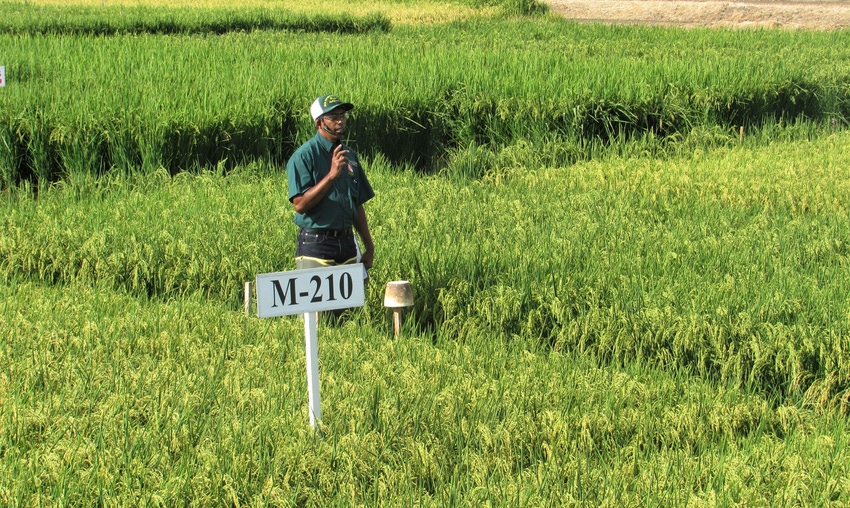
The latest in rice research is focusing on maximizing yields, partly by building disease resistance, as growers seek to get the most out of every acre they plant.
Scientists at the Rice Experiment Station in Biggs, Calif., last year released foundation seed for a new variety – called M-210 – with a gene that promotes resistance to rice blast disease.
The gene was developed with marker-assisted selection provided by the DNA lab at the industry-funded station, which works with researchers from the USDA and University of California Cooperative Extension.
Other new varieties recently developed at the station include Calaroma-201, a long grain with jasmine cooking quality, and S-202, a short grain with a smooth hull and high yield potential, the researchers told growers at a recent field day.
“If Hollywood has its walk of fame, welcome to the walk of star rice,” plant breeder Teresa De Leon told about 350 growers at the Aug. 28 gathering at the station.
DROUGHT AND RAIN
The quest for higher yields comes as rice planting in recent years has been complicated by two weather extremes – drought and abundant rainfall. During California’s historic drought from 2012-16, water uncertainties – including later-than-normal deliveries to leave water in the Sacramento River for fish – prompted many growers to plant only portions of their land.
In 2015, growers in the Golden State ended up planting about 423,000 overall acres of rice, down from 585,000 acres in 2011, according to the National Agricultural Statistics Service. California’s planted acreage of all varieties rebounded to 506,000 last year, including 455,000 acres of medium grain, which is dominant in the state.
This year, NASS estimated that 485,000 overall acres would be planted in the state, but that was before late spring rains delayed or prevented planting in many areas. At the research station, some test plots weren’t planted until June 15, said Bruce Lindquist, a plant sciences specialist from UC-Davis.
“That’s the latest we’ve ever planted rice,” he said.
Scientists have been working for years to develop varieties with resistance to diseases like blast fungus, which is known to cause lesions on leaves, stems, peduncles, panicles, seeds and even roots, according to the University of Arkansas Division of Agriculture Research and Extension.
IMPROVING YIELDS
Scientists have a systematic way of naming rice varieties, with a letter for long, medium and short, followed by numbers for maturity and order of release, De Leon said. The researchers grow all three types at the Biggs facility, even though medium grain represents more than 90 percent of the rice planted in California.
“M-206 is still the reigning queen in California, although M-209 and M-210 are coming on now,” De Leon said.
M-206 is an early-maturing medium grain released for seed production in 2003, explains the California Rice Commission. It has been broadly adapted to California’s rice-growing regions, but newer varieties could provide growers with as much as 20 percent more yield, said Luis Espino, a UCCE rice systems advisor based in Oroville.
In 2005 and 2006, M-207 and M-208 were released with a gene for blast resistance, but the latter succumbed to a new race of blast, the station’s scientists explain. The setback prompted the breeders to try adding several blast-resistance genes to M-206, finally releasing M-210 in 2018.
M-209, released in 2015, has in recent years been the station’s highest yielding medium-grain variety, averaging 10,040 pounds per acre compared to M-206 and M-205 yields of 9,290 and 9,240 pounds per acre, respectively, the researchers note. M-209 is adapted to warmer areas and may not perform as well where it’s cooler, such as in the San Joaquin Valley, the scientists say.
The M-210 variety has registered an average yield of 9,090 pounds per acre at the station.
BUILDING ON SUCCESS
The breeding program was one of several topics covered at the annual field day, which is sponsored by the UC and the California Cooperative Rice Research Foundation. Rotating groups of growers also heard talks on managing nitrogen fertilizer and evaluation of new weed control methods.
Station scientists say they want to build on the success of their DNA marker laboratory by expanding its capability to include genetics and genomics research, which will be the foundation of a genetics lab that is under construction.
Research efforts will also continue seeking to improve and develop specialty varieties such as waxy rice, aromatic rice and others while also working on grain quality, yield and disease resistance, according to the center’s website.
About the Author(s)
You May Also Like






